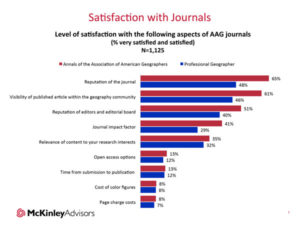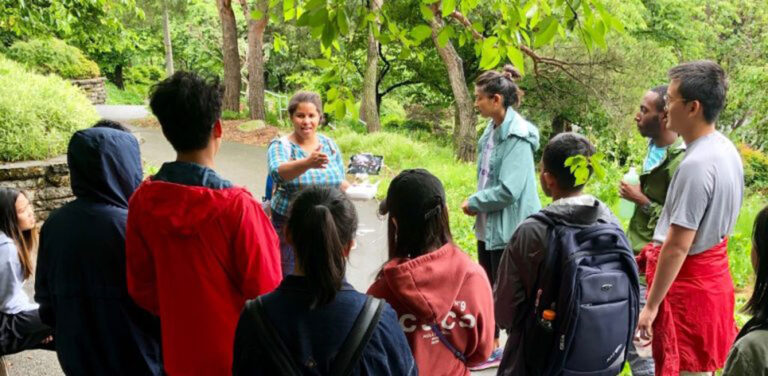Listening to Our Members: Part 2
 This is my last column as AAG president and it is perhaps the most important because I seek your input on a very significant matter for Council regarding our flagship journal, the Annals. Last fall we conducted a membership survey; as I reported in the previous month’s column, the purpose of the survey was to, “… understand current member perceptions, to identify areas where AAG is successfully delivering value today, and to uncover opportunities to provide greater value and support to the members.” We posed a number of questions to measure satisfaction with our journals and to explore interest in new publications. In this column I report briefly on the survey findings that then lead to the request for your feedback concerning the organization of the Annals.
This is my last column as AAG president and it is perhaps the most important because I seek your input on a very significant matter for Council regarding our flagship journal, the Annals. Last fall we conducted a membership survey; as I reported in the previous month’s column, the purpose of the survey was to, “… understand current member perceptions, to identify areas where AAG is successfully delivering value today, and to uncover opportunities to provide greater value and support to the members.” We posed a number of questions to measure satisfaction with our journals and to explore interest in new publications. In this column I report briefly on the survey findings that then lead to the request for your feedback concerning the organization of the Annals.
Survey Results
Overall, the support for our suite of journals was what I would characterize as tepid. Forty-two percent of members were extremely or somewhat satisfied with the journals compared to 68 percent who indicated satisfaction with the annual meeting. Only about one-quarter of members read an article per issue of either the Annals or Professional Geographer (PG). And as you can see from the graph below, while two-thirds of members are satisfied with the reputation of the Annals, only about one-third find that the content is relevant to their own research interests. I find that worrisome.

When asked, “What single change would make AAG journals more valuable to you?” the two most popular answers were, “New Content,” and “Balanced Content Matter.” These results are a little enigmatic, but when asked what new content members would like to read, the most popular answers were: applied and activist geography; public policy and management; industrial/commercial geography; physical/environmental geography; and social geography. I am surprised at this list since we have an Environmental Sciences section of the Annals and it would seem that these topics would be most welcomed in both PG and Annals.
Perhaps even more concerning is the disparity in satisfaction with our journals in terms of reputation, impact factor, and visibility across the discipline. As illustrated in this graph, physical geographers are less pleased with our publications than others but there appears to be a gap with GIS/cartography/remote sensors as well.

Recognizing that there is some discontent among members, we asked a series of questions to gauge interest in a new interdisciplinary journal focused on environmental change. Sixty-six percent of respondents said yes, they would support a new journal; 24 percent were not certain. The comments related to this question were most telling. The 11 percent who said they did not support the addition of a new interdisciplinary journal to the AAG suite expressed worries that “…yet another journal could dilute and segregate the overall human-environment core of the field.” The enthusiastic comments from the yes group included, “Geography should claim its place at the forefront of environmental research,” and “Campuses are losing interest in geography but gaining interest in interdisciplinary environmental programs, so this proposal matches that trend.” Overall, 71 percent of members said they were likely to read such a journal. Physical and coupled natural and human systems geographers showed strongest support for an environmental change journal, not surprisingly.
These findings give the Publication Committee chaired by Stuart Aitken, San Diego State University, our AAG publication editors, and Council much to consider. How can we make our journals stronger and more valuable to all our members? How do we help our editors to balance content, relevancy, impact, and visibility? Here is where we need your assistance.
Consultation
On behalf of the Publications Committee and AAG Council, we would like to know your thoughts about a proposal to eliminate the Annals section headings. How is it that we came to the current configuration? The existing format for the Annals was introduced in 1999 to address two perceived issues: 1) long-standing and continuing concerns about the lack of representation of certain aspects of the discipline (especially physical geography) in the flagship journal; and 2) concerns about perceived biases accruing to a single editor. Four sections, representing the breadth of the academic discipline of geography, were created, each with an editor taking responsibility for the subject area: Environmental Sciences; Methods, Models, and Geographic Information Sciences; Nature and Society; and People, Place, and Region. The four editors formed an editorial team.
We are considering removing the section headings in light of the survey findings and suggestions that the sections do not represent changes in the discipline and have the potential of characterizing articles in problematic ways. It is also clear that certain kinds of articles (e.g. papers that transcend the four major areas or papers that reflect on the discipline in general) are rarely submitted to the Annals and that the physical and environmental sciences are still underrepresented. Potential authors have raised concerns about not knowing to which section they should submit their work. Moreover, when two section editorships were advertised last year, more than one applicant stated that they were qualified to edit either section.
The proposal to remove the section headings is made with the understanding that the creation of an editorial team that represents the breadth and integrity of the discipline should continue. It is also understood that several substantive areas of geography can reside within the expertise of each editor but no one editor can encompass the whole discipline. The proposal is to remove the confusion and containment that accrues to the establishment of section headings while maintaining the disciplinary integrity of an editorial team. The proposal is endorsed by the current four Annals editors and the two most recent past editors.
So what do you think? Let us know by leaving your comments here (you will need to use your email address but no remarks will be attributed by name); by using Twitter with hashtag #AnnalsSections, or send your thoughts and suggestions to AAG Publications Committee chair, Stuart Aitken (saitken [at] mail [dot] sdsu [dot] edu) by July 31, 2016. This is important, so do express your opinion.
By the way, I can’t help but point out that in the first graph measuring satisfaction with AAG journals, eight percent of respondents expressed dissatisfaction with the cost of color figures and page charge costs. This is very humorous since we do not have either! Thanks for reading my columns for the last year and your generally kind comments.


